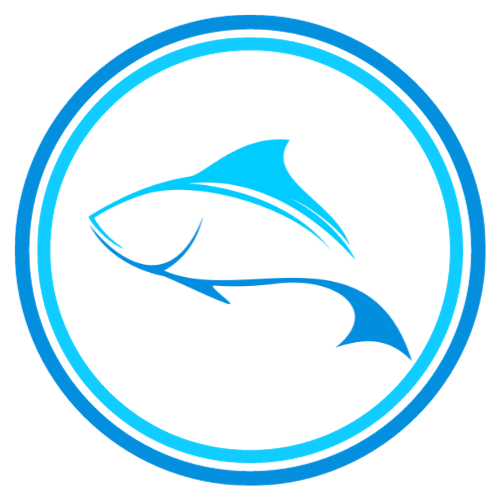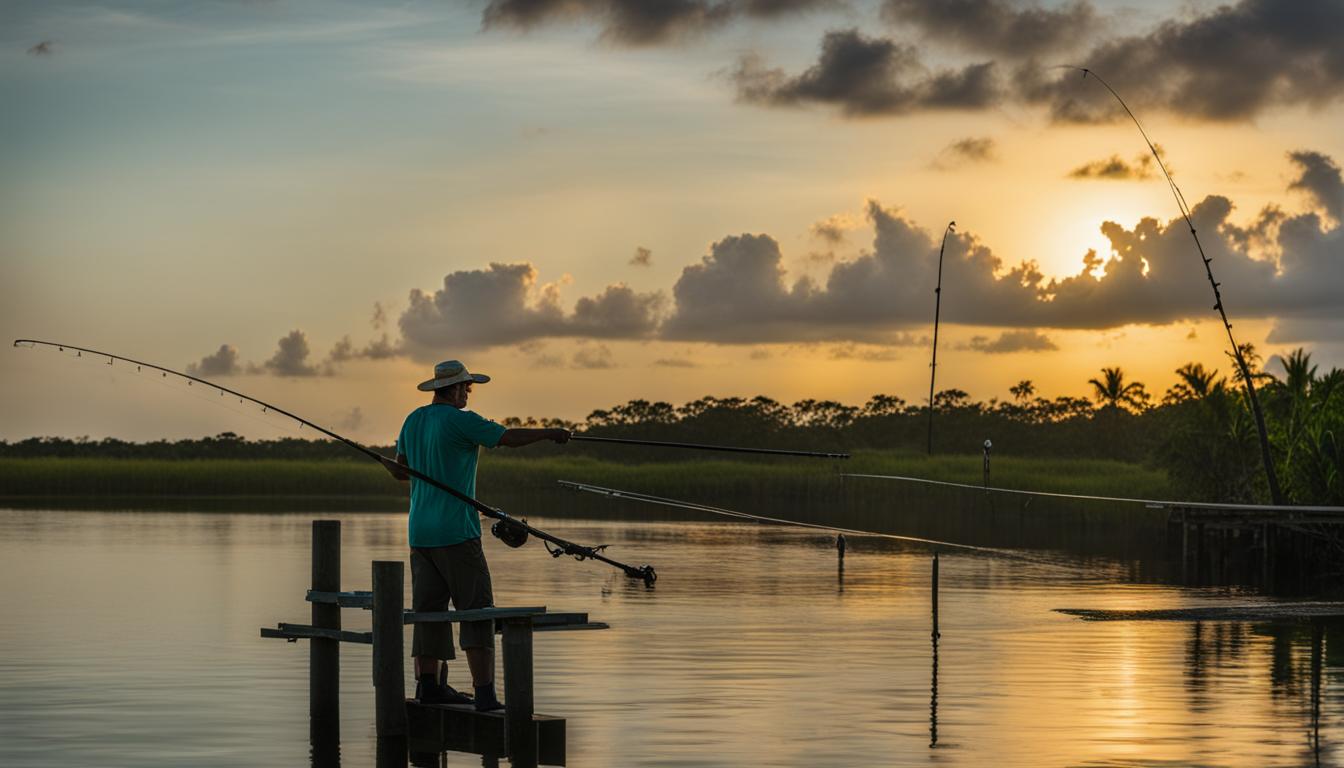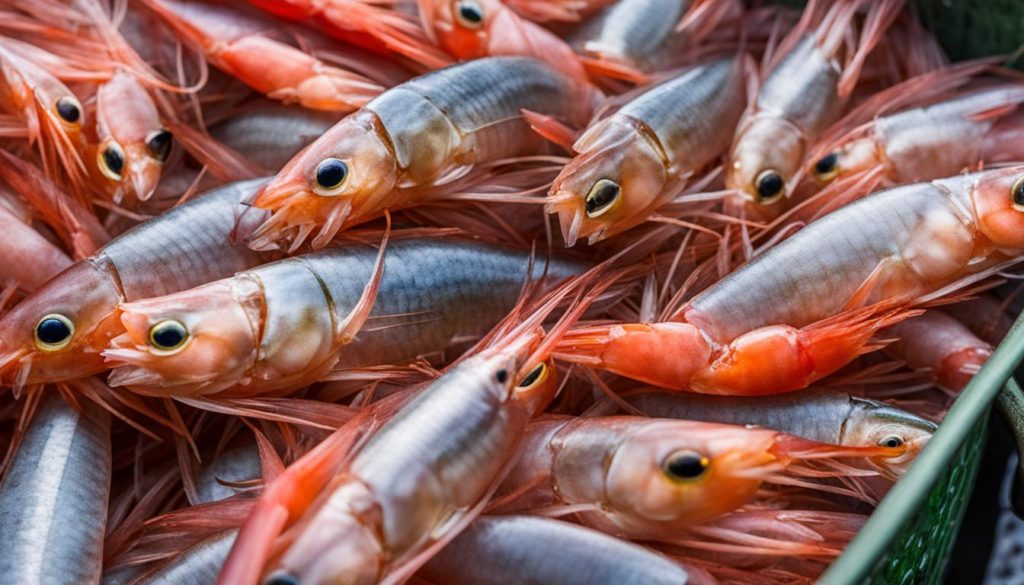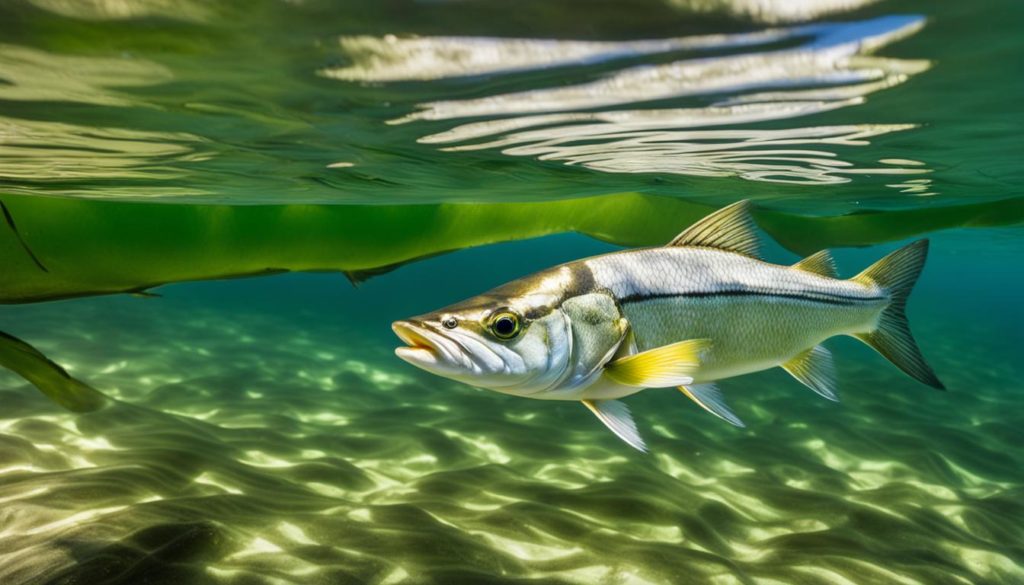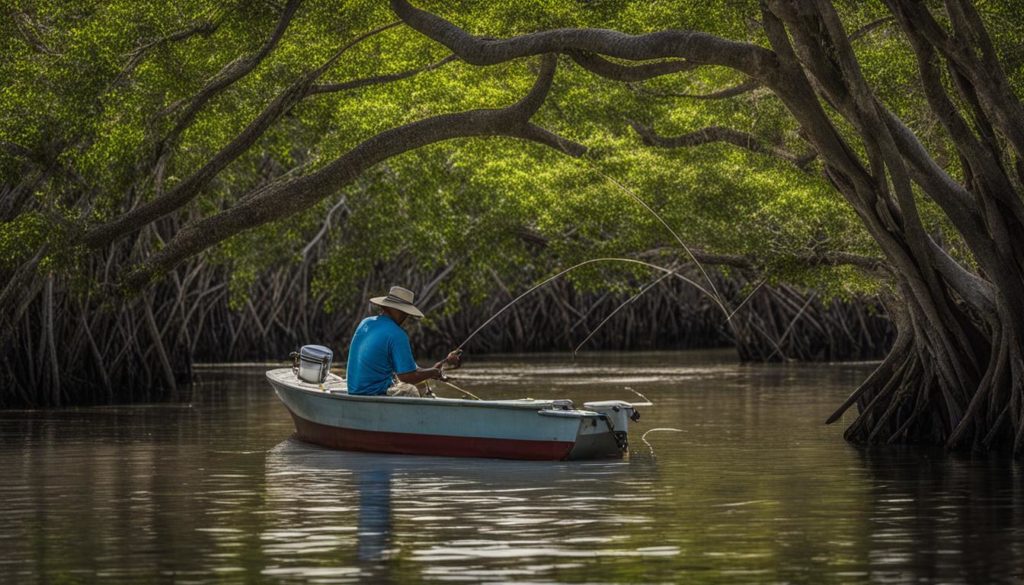Welcome to our expert guide on how to catch snook! Snook fishing is a thrilling sport that offers both excitement and challenge for anglers. Whether you’re a seasoned angler or just starting out, this comprehensive guide will provide you with proven tips and strategies to improve your snook fishing skills. From gear selection and bait choices to understanding snook feeding patterns and the best fishing spots, we’ve got you covered. Get ready to embark on a successful snook fishing trip!
Key Takeaways:
- Using the right gear, such as specific hooks, fluorocarbon leaders, and appropriate rods, is crucial for snook fishing success.
- Live bait, like pilchards, pinfish, and shrimp, is highly effective in attracting snook, but artificial lures can also be successful.
- Understanding snook feeding and migration trends can significantly increase your chances of targeting them successfully.
- Prime snook fishing spots include inlets, passes, mangrove islands, and points.
- Proper techniques, such as stealthy approaches and sight-casting, can greatly enhance your snook fishing experience.
The Right Gear For Catching Snook
When it comes to catching snook, having the right gear is essential for a successful fishing trip. Capt. Scott Moore, a world-renowned snook fishing guide, emphasizes the importance of using specific gear that is well-suited for targeting snook. Here are the recommended gear items that will help you increase your chances of catching these elusive and powerful fish:
- 254 Eagle Claw hooks with small barbs
- Bleeding hooks for extra attraction
- 30 lb. fluorocarbon leader
- 7′ 6″ to 8′ rods
Using the right gear plays a significant role in snook fishing. The 254 Eagle Claw hooks with small barbs provide excellent hook penetration, increasing your chances of landing a snook successfully. The bleeding hooks add extra attraction to entice the snook to strike. A 30 lb. fluorocarbon leader is recommended for its durability and ability to withstand the sharp gill plates of snook. Lastly, using 7′ 6″ to 8′ rods provides the necessary length and strength to handle the powerful fights of snook.
The Right Bait For Catching Snook
Capt. Scott Moore, a world-renowned snook fishing guide, emphasizes the importance of using the right bait when targeting snook. The right bait can make a significant difference in enticing snook to strike and increasing your chances of a successful catch. When it comes to bait selection for snook, Capt. Moore suggests using a variety of live baits and artificial lures.
Live Bait
Live bait is highly effective in attracting snook and triggering their predatory instincts. Capt. Moore recommends using live pilchards, pinfish, shrimp, cut bait, and crabs as bait options. These baits are natural food sources for snook and can be easily found in the waters where snook are prevalent. When presenting live bait, it is important to consider the size of the baitfish and match it to the size of the snook you are targeting. This will increase your chances of enticing a strike.
Artificial Lures
While live bait is often the preferred choice, artificial lures can also be effective in triggering a snook’s feeding response. Capt. Moore does not delve into specific recommendations in this particular video, but popular artificial lures for snook fishing include topwater plugs, soft plastic jerkbaits, and swimbaits. These lures can mimic the movement of live bait and attract snook in a variety of conditions. When using artificial lures, it is important to vary your retrieval speed and presentation to find what works best on any given day.
To determine the most effective bait for snook fishing on a particular day, it is essential to consider factors such as water clarity, current conditions, and the natural prey available to the snook. Experimenting with different baits and adjusting your approach based on the conditions will help you dial in to what the snook are actively feeding on.
Snook Feeding & Migration Trends
Understanding the feeding and migration patterns of snook is crucial for successful angling. Snook exhibit seasonal trends that dictate their movement and behavior. In the winter, snook move to deeper rivers and channels where the water temperatures are warmer. This is because they are cold-blooded and seek out areas with more favorable conditions. As the water heats up in the spring, snook migrate towards their summer beach homes. During these months, they can be found patrolling the swash near the shore.
Snook are most active during the early morning and late evening in the summer. This is when they feed aggressively, taking advantage of prey opportunities under the cover of darkness. In the fall, snook transition from the beaches back to the rivers as they prepare for the cooler months ahead. By understanding these trends, anglers can strategically plan their fishing trips and target snook in the best possible locations and at the most opportune times.
| Season | Location | Activity |
|---|---|---|
| Winter | Deeper rivers and channels | Moving to warmer waters |
| Spring | Summer beach homes | Migrating towards the shores |
| Summer | Swash near shore | Most active during early morning and late evening |
| Fall | Rivers | Transition from beaches back to rivers |
By aligning your fishing strategy with the natural feeding and migration patterns of snook, you can increase your chances of a successful catch. Knowing where and when to target snook will allow you to effectively present your bait or lure and entice these elusive fish to strike. Keep in mind that local conditions and environmental factors may influence snook behavior, so it’s important to stay informed and adaptable when planning your fishing trips.
Best Spots for Snook Fishing
When it comes to snook fishing, location plays a crucial role in increasing your chances of a successful catch. Here are some of the best spots to target snook:
1. John’s Pass
Located on the west coast of Florida, John’s Pass is known for its strong tidal flows, making it an ideal spot to attract snook. The strong currents create a feeding frenzy, drawing in these elusive fish. Be sure to plan your fishing trip during peak tidal flows for the best results.
2. Clearwater Pass
Clearwater Pass is another popular spot for snook fishing. This deep-water inlet connects Clearwater Harbor to the Gulf of Mexico, creating a prime location for snook to gather. Consider fishing near the bridge or along the jetties for the best chances of landing a trophy snook.
3. Boca Grande
Boca Grande, located on Gasparilla Island, is famous for its world-class snook fishing. The Boca Grande Pass, known as the “Tarpon Capital of the World,” also attracts plenty of snook during their migratory season. Fishing near the pass or along the nearby flats can yield excellent results.
Other notable spots include the mouths of rivers, mangrove islands, flats, and points. These areas provide ample food sources and shelter for snook, making them highly productive locations throughout the year.
| Spot | Location | Features |
|---|---|---|
| John’s Pass | West coast of Florida | Strong tidal flows, feeding frenzy |
| Clearwater Pass | Clearwater Harbor, Gulf of Mexico | Deep-water inlet, bridge, jetties |
| Boca Grande | Gasparilla Island | Boca Grande Pass, migratory snook |
Remember, snook fishing is not an exact science, and their behavior can vary depending on various factors such as weather, tides, and bait availability. It’s essential to stay adaptable and observe the conditions when choosing your fishing spot. By targeting these prime locations, you’ll increase your chances of hooking into a prized snook on your next fishing adventure.
Snook Fishing Techniques
Mastering the right snook fishing techniques is key to increasing your chances of landing these elusive and powerful fish. Whether you’re a seasoned angler or a beginner, incorporating these proven techniques into your fishing strategy will help you hook more snook. Here are some expert tips to improve your snook fishing game.
1. Stealthy Approach
When targeting snook, it’s essential to approach your fishing spot with stealth and caution. Snook have excellent hearing and can sense vibrations in the water, so it’s crucial to minimize any disruptions that may scare them away. Move slowly and quietly, avoid slamming the boat or making sudden movements. Consider wading to your fishing spot if possible, as this eliminates the disturbance caused by a boat and increases your chances of success.
2. Live Bait vs. Artificial Lures
Choosing the right bait is a critical factor in enticing snook to strike. Live bait options such as pilchards, pinfish, shrimp, cut bait, and crabs are highly effective at attracting snook. These baits mimic the natural prey of snook and increase your chances of a successful catch. However, fishing with artificial lures can also yield positive results. Opt for lures that imitate the movement and appearance of baitfish or other natural prey. Experiment with different colors, sizes, and retrieval techniques to find what works best for the snook in your area.
3. Sight-Casting
Sight-casting is a technique where you target snook that are visible near the surface, such as cruising or laid up along white sand beaches. This method is particularly effective during the summer months when snook are more active in shallow waters. By carefully observing their behavior and movements, you can make accurate casts that entice snook to strike. Use baits or lures that closely resemble the natural prey and present them in a way that mimics their typical movement patterns.
By incorporating these snook fishing techniques into your angling repertoire, you’ll be well-equipped to hook more snook during your fishing trips. Remember to always follow local fishing regulations and practice responsible catch-and-release to help preserve the snook population for future generations of anglers.
Snook Fishing Regulations
When it comes to snook fishing, it’s essential to understand and follow the regulations set by the Florida Fish and Wildlife Conservation Commission (FWC). These regulations are put in place to protect the snook population and ensure their sustainability for future generations. By adhering to these rules, you can contribute to the conservation efforts and enjoy a responsible and enjoyable fishing experience.
The snook fishing season typically runs from March through November, but it’s important to note that specific dates and regulations may vary depending on the location and species of snook. To stay up to date, be sure to check the FWC website or contact your local fishing authorities for the most accurate information.
Snook Fishing Regulations:
- Size Limits: The minimum size limit for snook is typically 28 inches total length, but it may vary. It is crucial to familiarize yourself with the specific size requirements to avoid any violations.
- Bag Limits: Bag limits refer to the maximum number of snook an angler can keep per day or per trip. Currently, the bag limit for snook is one per person per day. However, it’s important to check the regulations as bag limits can change.
- License Requirements: To fish for snook in Florida, a valid fishing license is required. Make sure you have the necessary permits and licenses before heading out on your snook fishing adventure.
- Closed Seasons: There may be periods during the year when snook fishing is closed to protect the fish during vulnerable times like spawning. It is crucial to be aware of these closed seasons to avoid any unintentional violations.
Remember, as an angler, it is your responsibility to know and abide by these regulations. By doing so, you not only ensure the sustainability of the snook population but also avoid potential fines or penalties. Responsible fishing practices go hand in hand with preserving our natural resources and maintaining a healthy ecosystem.
| Type of Regulation | Details |
|---|---|
| Season | March through November, varies by location and species |
| Size Limits | Minimum size typically 28 inches total length, check local regulations |
| Bag Limits | One snook per person per day, subject to change |
| License Requirements | Valid fishing license required |
| Closed Seasons | Periods when snook fishing is closed to protect fish during vulnerable times |
Snook Fishing Tips from Local Experts
When it comes to successful snook fishing, local experts have invaluable tips and insights to offer. These tips, gathered from experienced anglers, can greatly enhance your chances of landing a trophy snook. Whether you’re a beginner or a seasoned angler, incorporating these tips into your fishing strategy can make a significant difference.
“Fishing during the early morning and late evening is key,” advises Capt. Dave Pomerleau. During these times, snook are most active and likely to bite. The low light conditions make it easier for anglers to approach snook without spooking them.
“Using big baits like mullet or SpoolTek Stretch swimbaits can attract overslot snook,” shares Capt. Bouncer Smith. Overslot snook are larger and more coveted, providing an exciting challenge for anglers.
“Choosing the right locations is crucial,” emphasizes Norm Zeigler. Inlets, passes, mangrove shorelines, and grass flats are prime spots for targeting snook throughout the year. These areas provide ample food sources and cover for snook.
By following these expert tips, you’ll significantly increase your chances of a successful snook fishing trip. Remember to always respect local regulations and handle caught fish with care to ensure the preservation of the snook population.
Expert Tips at a Glance
| Captain | Tip |
|---|---|
| Capt. Dave Pomerleau | Fish during the early morning and late evening for more activity |
| Capt. Bouncer Smith | Use big baits like mullet or SpoolTek Stretch swimbaits for overslot snook |
| Norm Zeigler | Target inlets, passes, mangrove shorelines, and grass flats for high snook concentration |
Benefits of Catch-and-Release for Snook Fishing
Catch-and-release is a crucial practice in snook fishing that benefits both anglers and the snook population. By releasing caught snook back into the water, you contribute to the conservation and sustainability of these prized game fish. Here are some key benefits of practicing catch-and-release:
- Conservation: Catch-and-release helps preserve the snook population by allowing fish to reproduce and maintain healthy numbers. It ensures that future generations of anglers can continue to enjoy the thrill of catching snook.
- Environmental Impact: Releasing snook back into their natural habitat minimizes the disturbance caused to the ecosystem. It helps maintain the balance of the marine environment and preserves the overall biodiversity.
- Size and Age Distribution: By releasing larger and older snook, you contribute to maintaining a diverse age and size distribution within the population. This is essential for sustaining a healthy snook fishery.
- Research and Monitoring: Catch-and-release provides valuable data for scientists and researchers to study snook populations. This data helps in understanding migration patterns, growth rates, and overall behavior, leading to better conservation and management strategies.
By following proper catch-and-release techniques, you can increase the survival rate of released snook. Handle the fish with wet hands or gloves to minimize stress and avoid damaging their protective slime layer. Remove the hook gently using appropriate tools, such as a dehooker or needle-nose pliers, and release the fish in a calm and slow manner, allowing it to swim away strong.
“Practicing catch-and-release is a responsibility that every angler should embrace. It ensures the sustainability of snook populations and contributes to the overall health of our fisheries.” – Capt. Scott Moore
The Economic Value of Snook Fishing
Besides its ecological benefits, snook fishing also holds significant economic value. Snook fisheries attract anglers from around the world, contributing to local economies through tourism and recreational fishing expenditures. With catch-and-release practices, the snook population can be sustained for a thriving and lucrative fishing industry.
Get Involved in Snook Conservation
As an angler, you can make a difference by actively participating in snook conservation efforts. Stay informed about local regulations and fishing seasons, and ensure that you follow all guidelines when targeting snook. Share your knowledge and encourage other anglers to practice catch-and-release. Together, we can protect and preserve these magnificent game fish for generations to come.
| Benefits of Catch-&-Release | |
|---|---|
| Conservation | Catch-and-release helps preserve the snook population by allowing fish to reproduce and maintain healthy numbers. |
| Environmental Impact | Releasing snook back into their natural habitat minimizes disturbance to the ecosystem and preserves overall biodiversity. |
| Size and Age Distribution | By releasing larger and older snook, a diverse age and size distribution is maintained within the population. |
| Research and Monitoring | Catch-and-release provides valuable data for scientists and researchers to study snook populations and inform conservation strategies. |
Tips for Approaching Snook Fishing Spots
When it comes to approaching snook fishing spots, stealth and caution are key. Snook have a keen sense of vibrations in the water, so it’s important to approach the spot slowly and quietly. Avoid any sudden movements or loud noises that could startle the fish. Remember, patience is essential in snook fishing.
To prevent your boat from swinging and potentially spooking the snook, consider using power poles or staking a pole in the ground after anchoring. This will help keep your boat steady and minimize any disturbances. Another tactic to improve your chances of catching snook is to wade to your fishing spot. By avoiding the noise and disruption caused by a boat, you’ll have a better chance of getting close to the snook without them noticing.
Always keep in mind that snook are highly sensitive to their surroundings, so any disturbances or sudden movements can make them wary and less likely to bite. Take your time and approach the fishing spot with care, giving yourself the best chance of success.
Approaching snook fishing spots requires patience, stealth, and a deep understanding of the fish’s behavior. By being careful and observant, you can increase your chances of landing a trophy snook.
Remember, every fishing spot is different, and what works in one location may not work in another. Pay attention to the conditions, the behavior of the snook, and adjust your approach accordingly. With practice and experience, you’ll become more skilled at approaching snook fishing spots, and your success rate will improve.
| Approaching Snook Fishing Spots | Key Points |
|---|---|
| 1. Be stealthy and quiet | Snook can sense vibrations, so approach slowly and avoid loud noises. |
| 2. Use power poles or stake a pole | Prevent your boat from swinging and spooking the snook by stabilizing it. |
| 3. Consider wading | Avoid disturbances caused by a boat and get closer to the snook undetected. |
| 4. Be patient and observant | Pay attention to the conditions and behavior of the snook, adjusting your approach accordingly. |
Frequently Asked Questions
- How close should I get to the snook fishing spot?
- How important is it to be quiet when approaching snook?
- Can I use a trolling motor near snook fishing spots?
It’s best to stay at a safe distance to avoid spooking the snook. Use your observations and adjust accordingly.
Snook have a keen sense of hearing, so being quiet is crucial to prevent them from getting spooked and swimming away.
It’s best to avoid using a trolling motor if possible. Try to rely on other methods, such as poling or wading, to approach the spots quietly.
Snook Fishing Videos
To further enhance your snook fishing knowledge and skills, watching snook fishing videos can be highly beneficial. There are numerous videos available online that provide valuable insights, tips, and techniques from experienced anglers. These videos allow you to visually learn and understand different aspects of snook fishing, including bait selection, fishing techniques, and proper handling for catch-and-release.
By watching snook fishing videos, you can gain valuable knowledge from expert anglers who have years of experience targeting snook. These videos often showcase real-life fishing scenarios and provide step-by-step instructions on how to catch snook successfully. Whether you are a beginner looking to learn the basics of snook fishing or an experienced angler seeking advanced techniques, there are videos available to cater to your specific needs.
Snook fishing videos offer a visual learning experience that text-based guides may not provide. You can observe the techniques used by experienced anglers and see how they apply them in real-time. Additionally, videos allow you to see the behavior of snook in different fishing situations, helping you understand their preferences and habits.
“Watching snook fishing videos has greatly improved my angling skills. I have learned new techniques and gained valuable insights that I can apply on my fishing trips. It’s like having a virtual fishing mentor guiding me through the process. I highly recommend watching these videos to anyone looking to improve their snook fishing abilities.”
Top Snook Fishing Video Recommendations:
- “Snook Fishing Tips and Techniques” by Angler’s Digest
- “Mastering Snook Fishing: The Complete Guide” by Fishing TV
- “Snook Fishing Secrets Revealed” by Salt Strong
These videos provide comprehensive coverage of various snook fishing topics and are highly recommended by anglers worldwide. Whether you prefer instructional videos, action-packed fishing adventures, or in-depth tutorials, there is a video out there that suits your preferences and fishing style.
| Video Title | Duration | Views |
|---|---|---|
| “Snook Fishing Tips and Techniques” | 45 minutes | 10,000+ |
| “Mastering Snook Fishing: The Complete Guide” | 1 hour 20 minutes | 20,000+ |
| “Snook Fishing Secrets Revealed” | 30 minutes | 5,000+ |
Conclusion
Snook fishing offers an exciting and challenging experience for anglers. With the right gear, bait, and knowledge of snook feeding and migration patterns, you can greatly increase your chances of success. By following regulations and practicing responsible catch-and-release, you can contribute to the sustainability of the snook population. Whether you are a beginner or an experienced angler, incorporating the tips and techniques provided in this guide will improve your snook fishing skills and lead to a successful and enjoyable fishing trip.
FAQ
What gear do I need for catching snook?
The recommended gear for catching snook includes 254 Eagle Claw hooks with small barbs, bleeding hooks for extra attraction, 30 lb. fluorocarbon leader, and 7′ 6″ to 8′ rods.
What bait should I use for snook fishing?
Live bait such as pilchards, pinfish, shrimp, cut bait, and crabs are highly effective in enticing snook to strike. Artificial lures can also be successful, although specific recommendations are not provided in this article.
What are the feeding and migration patterns of snook?
Snook move to deeper rivers and channels in the winter, migrate towards beach homes in the spring, patrol the swash near the shore during the summer, and transition back to rivers in the fall.
Where are the best spots for snook fishing?
Inlets and passes such as John’s Pass, Clearwater Pass, and Boca Grande are great spots for snook fishing. Additionally, areas surrounding the mouths of rivers, mangrove islands, flats, and points are prime locations for targeting snook during different seasons.
What are some recommended snook fishing techniques?
Recommended techniques include approaching snook spots stealthily, fishing live bait or artificial lures with natural movement, and sight-casting to snook along white sand beaches during the summer months.
What are the regulations for snook fishing?
Snook fishing is regulated by the Florida Fish and Wildlife Conservation Commission (FWC). The season typically runs from March through November, but specific dates and regulations may vary depending on the location and species of snook. It is important to be familiar with size and bag limits to ensure compliance and protect the snook population.
What tips do local experts offer for snook fishing?
Local experts suggest fishing during the early morning and late evening, using big baits like mullet or SpoolTek Stretch swimbaits, and choosing the right locations such as inlets, passes, mangrove shorelines, and grass flats.
Why is catch-and-release important in snook fishing?
Catch-and-release helps ensure the sustainability of the snook population. By handling and releasing caught snook properly, anglers contribute to the conservation and preservation of this valuable game fish and allow for future generations to enjoy snook fishing.
How should I approach snook fishing spots?
Approach snook fishing spots slowly and quietly to avoid spooking the fish. Avoid swinging the boat, as snook may mistake it for a predator. Options for preventing boat swinging include using power poles or staking a pole in the ground after anchoring. Wading to your spot is another effective way to avoid disturbance.
Are there any recommended snook fishing videos?
Yes, there are numerous online videos available that provide valuable insights, tips, and techniques from experienced anglers. Watching these videos can enhance your snook fishing knowledge and skills.
